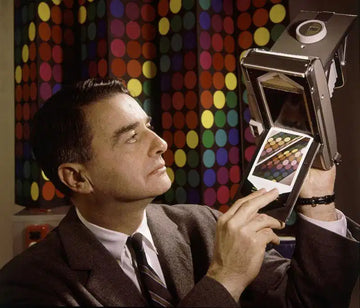
In the digital age, we are used to taking photos with smartphones and getting instant results. However, these photos easily get lost among the thousands of other images in our phone's gallery. The concept of "instant photography" began long before smartphones were invented, allowing photography enthusiasts to see a captured moment right in their hand.
Polaroid instant print cameras were first introduced in the late 1940s and were so revolutionary that they transformed the photographic landscape in the way we see it today. Many of us apply filters and textures to make our digital images look grainy, as if they were vintage. In fact, there are now many apps that let you create a fake Polaroid frame around your photo (we don’t endorse that ?).
The History of Polaroid Corporation
The Polaroid Corporation was founded by American scientist Edwin H. Land in 1937, but at that time, it was not known as a leader in instant photography. Polaroid used polarizer technology (an optical filter) to create various products, including 3-D films and glare-reducing glasses for dogs.
During World War II, the innovative company developed and manufactured numerous products for the armed forces, including infrared night-vision devices and color filters for rangefinders and periscopes, which allowed soldiers to look around walls, corners, or other obstacles.

After many years of trial and error, understanding camera and film techniques, Land cracked the system. Along with his physics instructor at Harvard, George Wilright, Edwin learned how to produce a camera for commercial purposes.
After this discovery in 1934, they invented Polaroid's polarizing light filters, which were often used for various film settings, for the Eastman Kodak Company.

Birth of Polaroid Photography
During a family vacation in 1944, Land’s three-year-old daughter asked him why she couldn’t see the picture he had just taken with her on his camera. Later that same day, the inventor claimed he had come up with the design for the camera, film, and chemistry that could fulfill his daughter’s wish. It took three more years until he finally realized his vision and introduced the first instant film to the public.
Land’s invention became a major milestone in the history of photography, as it transformed the traditional process into something that took just minutes. In 1948, the Polaroid Land Model 95 camera introduced this exciting technology to consumers. The original model had two separate positive and negative rollers that allowed the image to develop inside the camera. Initially, Polaroid made only 60 copies of the Land camera, but the company seriously underestimated demand — all units and cassettes were sold out in one day.


The Impossible Project

Despite Polaroid's popularity in the second half of the 20th century, the company filed for federal bankruptcy protection in 2001. It seemed as though the art of instant photography had come to an end. In 2008, the company officially announced it would cease production of its analog products. Fujifilm took over the market, and many Polaroid fans were left confused. However, the magic of instant photography was revived by a revival initiative known as The Impossible Project. In 2008, a small group of instant photography enthusiasts saved the last Polaroid factory in the world, located in the Netherlands. Reviving Polaroid instant photography was easier said than done. The factory’s machines were broken, the chemical formulas had been lost, and suppliers were out of work. But over time, the team made the impossible possible and released an exciting range of black-and-white and color film.
Now, Polaroid is all about capturing moments that you can keep with you forever. This rebranding was about making it clear to all fans, retailers, and partners that we are one brand, says Birkeland, with one name that represents the iconic company people have known and loved for the past nine decades, looking toward the future.
Polaroid Today
Polaroid has achieved remarkable success despite being on the verge of bankruptcy. Its largest workforce numbered 21,000 employees, and its highest annual revenue was $3 million. Moreover, its popularity is only increasing as the brand plans to release premium instant cameras targeted for holidays.
According to research group NPD, 3.5 million instant print cameras were sold in 2016, increasing Polaroid’s camera sales by 166% in just 12 months.
The instant camera market has also steadily grown over the years, with an annual growth rate reaching 16% from 2013 to 2016. Currently, Polaroid competes with Fujifilm, and both are in constant competition over prices, products, and even campaigns.
In 2017, the CEO of Impossible acquired the Polaroid trademark and IP. They relaunched Impossible as “Polaroid Originals” and released the OneStep 2 camera using a new film process, the “i-Type,” which more closely resembled the old Polaroids (while avoiding the costly cartridge battery). Later, Polaroid Now hit the market; this camera is not a complete rethinking of the camera today—it’s a “more friendly” redesign that follows the popular OneStep but adds improved autofocus, a light sensor that regulates the flash, a better battery, and a few other cool additional features like controlling the camera via the app (Polaroid Now+).
Polaroid: More Than Just a Camera
Polaroid has become a proud brand that will never be ready to bow out due to failures, competing brands, unsuccessful products, revived factories, and bankruptcies.
Despite the serious hardships, the brand continues to invest in innovation, products, better marketing strategies, more accurate customer information, and other investments. Even consumers have celebrated the unique concept of instant photo sharing so much that the brand has maintained its charm, despite being around for over 75 years.
All of this is the result of audience engagement, constantly evolving products, analysis of customer needs, and, ultimately, the power of nostalgia in marketing that has brought the brand to where it is today.




